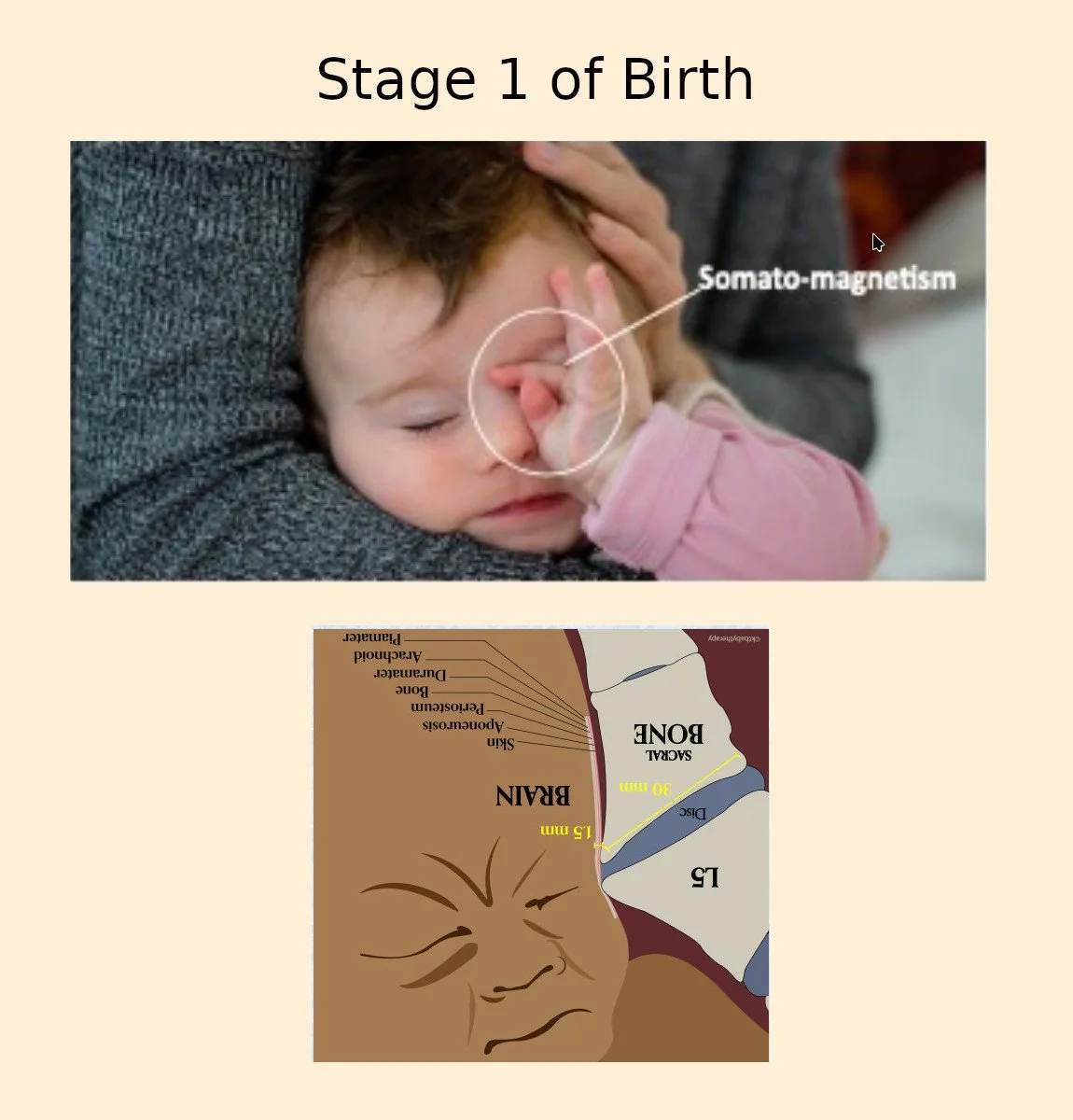BABY BODY LANGUAGE: INTRODUCING SOMATO-MAGNETISM
Throughout much of the day, babies are communicating their deepest psychological and personal needs. We all see it, but how do we recognize it? Once we've learned to recognize it, what do we need to know about it, what are we supposed to do about it?
"Somato-magnetism" describes the non-volitional but non-random body movements and gestures babies make as a consequence of and in reaction to energies of specific events (from minor "normal" pre & perinatal traumas ) that became imprinted into their soma and their psyche.
Birth-related "Baby Body Language" (BBL) including somato-magnetism, is generated from experiences which imprint energies into living tissues so as to become somaticized: held in the body, with experiential and memorable counterparts constellated in the brain.
The psycho-emotional components are stored in event-caused causeways threaded between the impact areas and the brain, ready to light up and cause action (pointing). If an event is strong enough, an implicit memory is created. Implicit memories take up a lot of space in the brain and can hijack thinking and behavior so as to diminish the quality of life and the integrity of one’s actions. These implicit memories radiate into gestures during certain windows of a baby's activity.
Somato-magnetism is over-ridden when a baby is in a state of social attentiveness, active feeding, or sleeping. Much of the rest of the awake time though, somato-magnetism is repeatedly expressed. When recognized, BBL, and especially somato-magnetism which is site specific, is a valuable parenting tool, and for practitioners a valuable diagnostic tool that distinctly indicates specific birth trauma pathology, the location in the cranium where it is held, and the stage of birth the baby was in when it was created.
Knowing when a baby is expressing somato-magnetism from birth imprints and seeing what is being requested ups your game. Somato-magnetism enhances the efficacy of your practice, inspiring specific treatment protocols for osteopaths, cranio-sacral therapists, baby massage therapists, chiropractors, doulas and midwives, pre and perinatal practitioners, postpartum coaches, lactation specialists and other somatic-oriented practitioners. Of special note is that parents can be informed by somato-magnetism and can more easily offer Accurate Empathy and specific healing contact.
Stage 1 of Birth
Somato-magnetism highlighting where it still feels crunchy inside.
Somato-magnetism is characterized by non-volitional, non-random gestures such as when babies press one or both hands against one or both of their eyes, ears, or temples, forehead and face. The gestures have an ineffable quality, as if the hands or fingers, aimed and moving to the site of a birth imprint, are cruising, obedient to an invisible puppeteer. In fact, they are. One’s psyche glides the declamatory moves, the way an orchestral conductor creates trails with the tip of the baton: trails emphasizing content and intensity. If the baby got hurt during the beginning of birth, then it will show where the implicit memory is coming from, usually only one one side, and with a hand gesture to the side where it hurts from compression against the LSP.
Right or left side lie somato-magnetism can indicate vision issues, orientation challenges, eye infections, a diminishment of full usage of the visual apparatus, ongoing irritating pain from inflammation, and disruption of optimal relationships of the bones, tendons and Iigaments due to compression and drag forces against the mother’s LSP. It’s self-evident, really. The baby’s psyche is saying, something is awry…right here. If you understand the dynamics of cranial birth trauma, you may know the psycho-emotional issues you might be dealing with, and you’re guided right where to ply your skills. Stage 1 trauma can drive the eye closer to the midline of the face, It can cause that eye to look smaller, have less scleral on one or both sides of the pupil/iris, can cause the lie side eye to appear recessed – pressed farther into the cranium.
Somato-magnetism Stage 2 of Birth
Implicit memories can be held on both sides of cranium
Once a baby descends deeper into the birth canal, pressure comes from both sides now, smushing in from the pubic symphysis as well as the LSP.
If the baby was stuck longer here, then he or she will feel it more on both sides now, and will use somato-magnetism to show you where it hurts.
Image girl: She looks like she’s showing where the pressure went in and and where she is still feeling it. Stress can activate unresolved birth imprints and come off as “temper tantrums.”
Image boy: He looks like he can feel where his tentorium Membrane was smushed or warped, and maybe even suffered lesions from birth trauma. It looks like he is trying to do a cranio-sacral maneuver to make more room in there!
Somato-magnetism Stage 3 of Birth
Before finally emerging, the baby slides out with it’s face against the sacrum.
When somato-magnetism motivates babies to press both hands in front of their face, esp. if they are pulling down, it signifies an implicit memory generated from Stage 3 of Birth.
Hand gestures with both hands in front of the face indicate there are still implicit memories there.
Silly Putty Stretches
How to make room?
A cousin of the somato-magnetism gestures is the ”Silly Putty Stretch”. It is a movement or combination of intra-cranial movements babies make when they are trying to make room inside where they have lasting pain, inflammation, or a sense of compression.
When parents or other caretakers as well as professionals are able to recognize and empathize with a baby's experiences, this opens a whole new pathway towards healing and emotional resolution.
Parents can then observe and support their babies with empathy and compassion through understanding baby body language which deepens the bond with their child. Professionals working with babies are much better able to address and heal birth-related issues, involving observation, empathy, and hands-on techniques.






